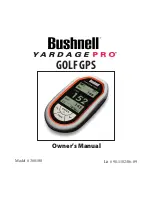
4
GPS Bluetooth Receiver
Installation and Operation Manual
NAVMAN
1 Introduction
The US Government operates the GPS system.
Twenty-four satellites orbiting the earth broadcast
timing signals which are freely available to use. The
positions of these satellites are constantly changing.
The GPS receiver tracks signals from all satellites
visible above the horizon and uses measurements
from all satellites more than 10° above the horizon
to calculate exactly where it is on earth. This is called
the GPS position.
A GPS receiver can receive signals from the GPS
satellites when it is almost anywhere on earth.
The receiver is accurate even at high speeds and
accelerations.
•
Extremely long battery life; around 40 hours of
operation from one set of AAA alkaline batteries.
(2 second update, trickle power mode)
•
No operator setup or adjustment required; the
only operator control is the On/Off switch.
•
25 x 25 x 4 mm (1 x 1 x 0.2 in) patch GPS
antenna with sensitive 12-channel GPS
receiver chipset.
•
Available in two versions. These are identical
except for resistance to water:
The GPS 4500 is fully waterproof and is
designed to be mounted outdoors, for example
on the roof of a vehicle.
The GPS 4400 is not waterproof and is
designed to be mounted indoors.
•
An MCX connector for an external GPS
antenna and a connector for an external power
supply (GPS 4400 only).
Cleaning and maintenance
Clean the receiver with a damp cloth or mild
detergent. Avoid abrasive cleaners, petrol or other
solvents.
Do not paint the receiver.
Bluetooth is an industry standard wireless network
for linking peripherals to Bluetooth enabled portable
computers or PDAs. Bluetooth is fast, economical
The GPS Bluetooth Receiver is a peripheral for a
portable computer or PDA which calculates where
the receiver is on earth. The receiver has:
•
A GPS antenna and GPS chipset to receive
GPS signals and calculate the GPS position of
the receiver.
•
A Bluetooth link to send the GPS position to a
portable computer or PDA.
The receiver is powered by its own internal batteries.
In a typical land navigation application (see below),
the GPS Bluetooth Receiver is mounted on a vehicle
and sends the GPS position to a portable computer
or PDA in the vehicle for use by a navigation
application.
GPS
antenna
GPS Bluetooth Receiver
Portable computer or PDA
(Bluetooth enabled)
Bluetooth
link
Batteries
GPS
chipset
Radio signals from
GPS satellites
Bluetooth network
radio signals
Bluetooth
link
Navigation
application
and uses little power. The GPS Bluetooth Receiver
uses a Class 2 Bluetooth link, with a range of at least
10 m (33 ft).
Features of the GPS Bluetooth Receiver
What is Bluetooth ?
What is GPS ?




























